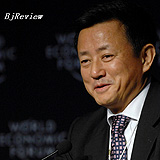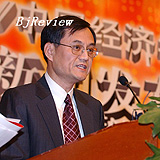|

What is the relationship between reform and development? And to be specific, how has reform boosted China's economic growth?
Fan Gang (Secretary General of the Research Foundation affiliated to China Society of Economic Reform): It is conventionally believed that China's tremendous development over the past 30 years has been achieved through its competitive edge in low labor costs and rapid capital accumulation, rather than efficiency improvement. The annual growth level that kept at 9 percent-10 percent should be mainly attributable to factor inputs in production. In fact, 6.7 percent of the total growth of the gross domestic product (GDP) was driven by factor inputs during 1979-88, and the rate narrowed to 5.16 percent during 1989-98 and rebounded to 5.36 percent during 1999-2005, respectively. Meanwhile the increase in productivity is also noticeable. It is estimated that productivity improvement contributed 4.4 percent to total GDP growth in the 1990s, and the contribution rate maintained at 3.7 percent since then, a significant share of the total.
The improvement of productivity is the result of flourishing private sector, as well as a raised education level. At the same time, more investment in R&D should be factored in, though not enough so far. In addition, the improvement in its basic infrastructure remarkably adds to China's attractiveness to foreign capital, and the country's rapid urbanization process has changed the old industrialization model in rural areas. The introduction of foreign capital and booming foreign trade have played a significant role in transforming the economic structure.
The fact that China's productivity maintained a year-on-year growth rate of 3 percentage points-4 percentage points may explain the "high growth, low inflation" phenomenon that has lasted for almost 10 years in the country. Despite soaring costs on energy resources and raw materials, prices of consumer goods are comparatively low for large profit margins. And that could be impossible without productivity increase.
This growth pattern is predicted to remain effective in the future 20 years with slight changes in the contribution rates of various elements. Among them, contributions made by cheap-but-qualified labor forces are dropping, with other elements, such as human capital, R&D, corporate innovation and urbanization, key for future development, growing stronger.

It is a concern that more social wealth and higher efficiency seem to be "ineffective" to curb worsening inequality, particularly in income distribution. What has the reform done to affect the income gap and social fairness?
Zhang Weiying (Dean of the Guanghua Business Management School, Peking University): Almost every system in fact is more or less involved with distribution of social wealth, and thus more reforms will be seen in this sector. China's reform on income distribution system is a transition from government-oriented to market-dominated. Until now, the government's role in resource allocation remains foremost, while market is playing an increasingly big part in income distribution.
The whole nation has been lifted from poverty through 30 years of reform, while the income gap is evidently dividing the country. According to an assessment by the World Bank, the majority of China's rural population has been relieved from poverty, with the poor accounting for 7.8 percent of the total in 2001, and back in 1981, more than half of the population was struggling against poverty.
However, China's enlarging income gap has ignited enormous controversies. Over the past 30 years, all Chinese people have shared the national prosperity, but at various levels. It is worried that, a widening wealth gap will harm social fairness. But it could not be the whole story, if we changed a view to look at this problem. John Pencavel, a professor of economics at Stanford University, devised a research model to assess China's wealth distribution by dividing the total population into five groups to see changes during 1990-95. Results show that, 43.9 percent of the richest were still the most affluent, and 49.6 percent of the lowest paid remained poor after five years. Compared with the United States in 1993-98, 59.1 percent of the wealthiest were still on the rich list in 1998, and as high as 70.4 percent of the poor were still suffering from poverty through these years. Higher wealth liquidity indicates more opportunities for civilians to search for their own wealth.

From a vertical perspective, China's reform and opening-up policy has brought in a lot of changes, but how about the situation if we make horizontal comparisons worldwide?
Qian Yingyi (Professor on Economics, University of California, Berkeley): China's economic reform, which began in 1978, enables it to keep growing for nearly 30 years, marking a milestone in the chapter of 20th century economics.
Compared with other world economies, China's performance is not that unique, as well as its reason for development. If we put China together with other transitional economies like Poland and Russia, typical East European nations, China is quite different in choosing a development path. But if we look at Japan in 1950, China's Taiwan in 1958, South Korea in 1962, and the Chinese mainland in 1978, respectively, we may easily find some similarities shared by all of them at their initial stages of development.
The World Bank had studied eight of the fastest developing countries and regions in East Asia (the Chinese mainland not included), and came out with a publication in 1993, saying that their high growth was nourished by stable macroeconomic situation featuring low inflation, high deposits, strong investment, abundant young laborers (population dividends) and enhanced basic education.
|
